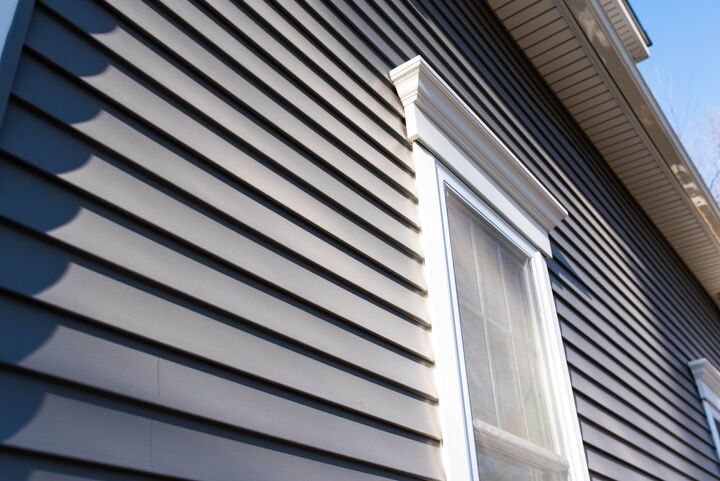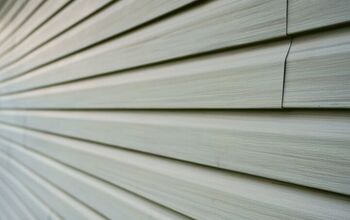Composite Vs. Vinyl Siding: What Are The Major Differences?

Vinyl siding is extremely popular, even if you’re in a location that is famous for being rough on siding. When you’re trying to get new siding, you’re going to be presented with vinyl options as well as options that are less common. One of the rarer ones is composite siding. For the right home, composite can be the best choice ever. For others, it’s all about vinyl. The question we’re asking today is, which is better overall?
Composite siding is a wood-based siding choice that is known for durability, a rustic appearance, and for being cost-effective. Vinyl siding is famous for being affordable, having a wide range of looks, and for its high degree of mold resistance. Composite siding is often more earth-friendly.
There are a lot of factors that we have to touch on in the battle between composite vs. vinyl siding. Many people tend to favor one over the other. So…wondering which one is right for you?
Do You Need Vinyl Siding Installation or Replacement?
Get free, zero-commitment quotes from pro contractors near you.

Before We Begin: An Introduction To Both Materials
Composite siding is made from a bunch of wood that has been pressed and glued together. In this way, it’s a lot like composite shingles. Vinyl, on the other hand, is made from a polymer that’s about vinyl. Both are considered to be excellent and durable materials for your home’s exterior. Now that we’ve gotten that formality out of the way, let’s talk about the pros and cons of each.
What Are The Pros And Cons Of Composite?
Composite is a cool material for anyone who wants to have a rustic and woody look to their home. Here’s the scoop on this genre of siding:
- Composite siding offers a very affordable way to get wood exteriors. Regular cedar shingles or wood shake will cost an arm and a leg compared to composite. This is a bargain hunter’s pick, fo’ sho’.
- Many companies offer environmentally-friendly composite shingles. Sustainability is always a plus, especially if it means your home will be covered nicely.
- Most composite will be strong and impact-proof. At times, it can outdo both vinyl and sold wood shake. Not many wood products will be able to say that.
- Insulation is never an issue with composite siding. It’s actually one of the best materials for insulation. This is why many homes in places like North Dakota or Alaska prefer composite.
- Composite is also more resistant to the elements. Unlike regular wood, composite will be able to handle UV and water better. It’s due to the binders in there. In most cases, it is tied with vinyl for resistance to the issues that nature can spark.
- It also happens to be easier to maintain and install. Vinyl actually tends to need more maintenance than composite.
- The downside to this material is that it can be limited in terms of appearance and colors. If you like the log cabin look, then great. Otherwise, you are out of luck.
- Oh, and composite tends to be reliant on wood prices. We’re in a wood shortage right now, so it actually tends to be more expensive than vinyl these days.
What Are The Pros And Cons Of Vinyl Siding?
Vinyl is the default material for siding in most parts of the United States, and to a lesser point, parts of Europe. When you take a look at the basics, it’s easy to understand why…
- Vinyl siding can come in virtually any color and style. If you want a modern home without a wood appearance, this is a good choice. On the other hand, if you want a log cabin look, you absolutely can fake it with the right vinyl.
- Vinyl can also be one of the more affordable options as far as siding goes. Because it is synthetic, prices won’t fluctuate with the prices of wood. It’s a lot more predictable these days and is typically cheaper.
- People tend to feel more comfortable with maintaining vinyl. Vinyl is notoriously easy to maintain and everyone knows how to work with it. That alone makes it a good pick for people who are green to home upgrades.
- Many siding experts also believe vinyl to be the most durable and weather-resistant material for home siding. It doesn’t attract termites, woodpeckers, or any other types of wood-eating bugs. It also happens to be very resistant to mold and mildew.
- The problem is that vinyl often takes more money and time to install than composite. This isn’t always true, but it’s common enough that people tend to complain about it when they find out how affordable composite installs can be.
- Vinyl can require marginally more maintenance than composite. It’s still low effort, but if you are looking for the lowest effort maintenance, it’s probably composite.
How Much Do Vinyl And Composite Siding Cost?
Both vinyl and composite are considered to be superb for people who want affordability. They are both good “bang for your buck” siding options. However, composite siding is currently more expensive than vinyl due to supply shortages that are expected to continue for the next couple of years.
Composite siding will be between $4 to $8 per square foot. If you want to get vinyl siding, you should expect to pay between $3.50 to $6 per square foot. So while they are both pretty affordable compared to “luxury” types of siding, they still offer a lot of benefit for you.
Note: Vinyl can cost more to install in many situations, but not all. You may need to talk to contractors in order to find out whether you will have to pay a premium price to get your vinyl installed.
Related Questions
Does wood composite siding offer any kind of insulation?
Many types of siding offer good insulation, but few can offer it as well as wood composite siding. Composite is famous for offering some of the best insulation. This makes it an ideal siding material in parts of the country that deal with extreme cold. Nothing will keep your home as warm as a nice, thick layer of composite will.
Is wood composite siding more flammable than vinyl?
Believe it or not, both wood and vinyl siding will catch fire fairly quickly compared to other materials like brick. With that said, both materials are treated with flame-retardant chemicals as a basic part of their manufacturing process. Due to the way they are made as well as the fact that there’s only so much that treatment can do, both materials tend to be equally flammable.
Does composite siding require regular painting?
While you can paint your composite siding if you want to, the truth is that this is a type of siding that does not require regular painting. This is true on both a functional and an aesthetic level. Composite siding’s unique makeup means that the color that it has baked into it won’t budge. It’ll stay looking bright and fresh for years to come.The fact that composite is also not entirely wood also comes into play here. Many people use paint as a way to ward off pests. Since composite isn’t fully wood, animals don’t want much to do with it. There’s no need for paint on a functional level, either.
Do You Need Vinyl Siding Installation or Replacement?
Get free, zero-commitment quotes from pro contractors near you.

Which Option Is Best For You?
Honestly, in most situations, it’s a draw. Both composite and vinyl siding have very similar qualities that tend to draw the same types of builders to them. That’s why they’re both as popular as they are. If you are looking for affordability or a wider range of looks, then vinyl is the clear winner.
On the other hand, if you want a woodsy-outdoorsy home that has sturdy shingles as the siding, then you might be better served by composite. It’s definitely the more eco-friendly option, and for many people, that alone is worth the splurge. Aside from that, both vinyl and composite offer extremely similar behavior when all things are said and done. They’re cool like that.
Related Guides

Ossiana Tepfenhart is an expert writer, focusing on interior design and general home tips. Writing is her life, and it's what she does best. Her interests include art and real estate investments.
More by Ossiana Tepfenhart



























